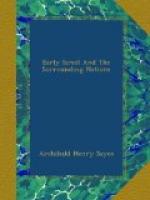The pre-historic race or races had already reached a fair level of civilisation—neolithic in type though it may have been—when a new people appeared upon the scene, bringing with them the elements of a high culture and a knowledge of working in metals. These were the Pharaonic Egyptians, who seem to have come from Babylonia and the coasts of southern Arabia. Cities were built and kingdoms were founded on the banks of the Nile, and the older population was forced to become the serfs of the new-comers, to cultivate their fields, to confine the Nile within artificial boundaries, and to carry out those engineering works which have made the valley of the Nile what it is to-day.
The Pharaonic Egyptians are the Egyptians of history. They were acquainted with the art of writing, they mummified their dead, and they possessed to a high degree the faculty of organisation. The gods they worshipped were beneficent deities, forms of the Sun-god from whom their kings derived their descent. It was a religion which easily passed into a sort of pantheistic monotheism in the more cultivated minds, and it was associated with a morality which is almost Christian in its character. A belief in a future world and a resurrection of the flesh formed an integral part of it; hence came the practice of embalming the body that it might be preserved to the day of resurrection; hence too the doctrine of the dead man’s justification, not only through his own good works, but through the intercession of the Sun-god Horus as well. Horus was addressed as “the Redeemer;” he had avenged the death of his father Osiris upon his enemy Set, the lord of evil, and through faith in him his followers were delivered from the powers of darkness. Horus, however, and Osiris were but forms of the same deity. Horus was the Sun-god when he rises in the morning; Osiris the Sun-god as he journeys at night through a world of darkness; and both were identical with Tum, the Sun-god of the evening. The gods who watched over the great cities of Egypt, some of which had been the capitals of principalities, were identified with the Sun-god in these his various forms. Thus Ptah of Memphis became one with Osiris; so also did Ra, the Sun-god of Heliopolis, while in those later days when Thebes rose to sovereign power its local god Amon was united with Ra.
Along with this higher and spiritual religion went—at least in historical times—a worship of sacred animals. The anomaly can be explained only by that mixture of races of which archaeology has assured us. Beast-worship must have been the religion of the pre-historic inhabitants of Egypt, and just as Brahmanism has thrown its protection over the superstitions of the aboriginal tribes of India and identified the idols of the populace with its own gods, so too in ancient Egypt a fusion of race must have brought about a fusion of ideas. The sacred animals of the older cult were associated with the deities of the new-comers; in the eyes of the upper classes they were but symbols; the lower classes continued to see in them what their fathers had seen, the gods themselves. While the Pharaonic Egyptian adored Horus, the older race knew of Horus only as a hawk. If we may trust Manetho, the Egyptian historian, it was not till the beginning of the Second historical dynasty that the sacred animals of popular worship were received into the official cult.




